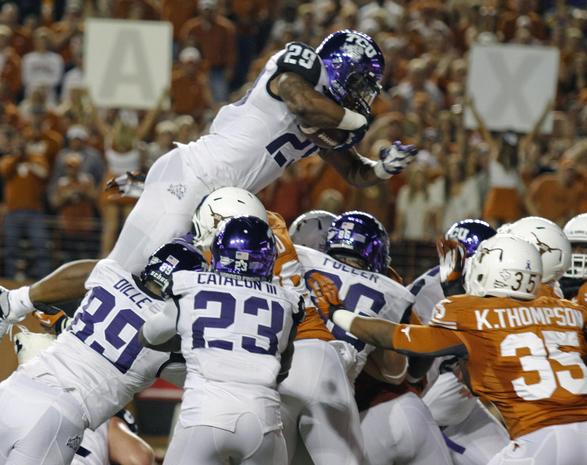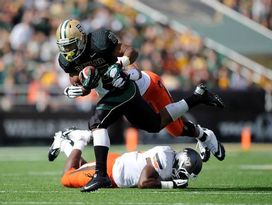The Big 12 seemed to fly under the radar somewhat last season. The league had a bunch of solid teams, but other than Kansas State, nobody seemed to stand out.
The Wildcats were a late-season loss away from playing for the national championship, but only one other team in the conference had double digit wins.
Traditional league powers Texas and Oklahoma had down years, at least by their standards (a combined 19-7 is nothing to be ashamed of, but these programs expect national title contention).
Oklahoma State and Baylor had successful seasons considering the star power they lost from the previous season. Texas Tech continued its bowl streak despite some controversy at the head coaching position, and TCU managed to have a winning record in its first year in a BCS conference despite suffering some injuries, suspensions, and the loss of star quarterback Casey Pachall for most of the season following a DWI arrest and subsequent substance abuse suspension.
Iowa State continued its steady progress under Paul Rhoads, pulling off a couple big wins while making a bowl game for the third time in four years.
West Virginia’s season did not go according to plan. The Mountaineers entered the season with high hopes after demolishing Clemson in the Orange Bowl, and for the first few weeks, they exceeded those expectations. West Virginia’s offense was dynamic, and quarterback Geno Smith was touted as the Heisman favorite as he led the ‘Eers to a #5 ranking.
The wheels fell off with a loss to Texas Tech, and West Virginia lost five consecutive games. As good as the offense was, the defense was equally as bad. During that five-game stretch, the Mountaineers didn’t hold an opponent to less than 39 points.
Smith is gone, along with explosive receiver Tavon Austin, leaving the Mountaineers with big holes to replace on offense while still trying to fix the defense.
As for Kansas, well all you need to know is that head coach Charlie Weis called his own team a “pile of crap.”
So what will 2013 hold in store for the Big 12?
A national title isn’t likely–too many teams would have to lose for a Big 12 team to make the title game–but this should be a fun season. Pachall’s back for TCU, and Art Briles is building something special in Baylor.
Oklahoma State will continue to light up scoreboards, and Oklahoma will be good again.
Kansas State loses quarterback Collin Klein, but with the wizardry of Bill Snyder, the Wildcats will be tough to beat. Texas is shaky–they are reminiscent of Florida State: lots of preseason hype about them being “back” only to disappoint once the season starts–but the Longhorns do have talent.
The Big 12 may not have any elite teams, but they do have a lot of quality programs. Only Kansas is a true-bottom feeder.
Cream of the Crop
TCU, Texas, Oklahoma State, Oklahoma, Baylor
As stated above, the Big 12 is lacking any truly elite teams. There is no Stanford or Alabama here. What the conference does have is a tremendous amount of depth. Other than Kansas, there are a large number of really quality teams that can, and will, beat each other up.
Iowa State is probably the weakest of the non-Jayhawk bunch, but the Cyclones have built a reputation for upsetting someone every season.
In what should surprise no one, the Big 12’s power is centered in the states of Texas and Oklahoma. The top five teams in the conference hail from those two states. All have significant potential and significant questions, and each one is capable of winning the Big 12.
I’m going out on a limb here, but TCU is my pick to win the Big 12 this year. The Horned Frogs adjusted pretty well last year to the upgrade in competition, especially when one factors in injuries, off-the-field issues (to put it mildly), and the fact that they lost their starting quarterback a month into the season and had to go with an unproven freshman.
Considering all that, it is remarkable that TCU went 7-6 and held its own.
Three of the losses were by less than a touchdown, and the benefit of playing so many young players is that they now have experience. Fifteen starters return from a squad that beat Baylor and Texas on the road. Gary Patterson will always have a strong defense, but the offense should return to the explosive unit that terrorized the Mountain West the past few years.
Pachall is back, as is running back Waymon James, and they’ll be joined by a bevy of quality receivers. If they can regain their explosiveness, they’ll be the perfect counterpart to a young, stout defense that returns nine starters.
The Horned Frogs should once again field one of the best defenses in the nation.
League titan Texas rebounded and went 9-4 last year, and the Longhorns have 19 starters returning as well as injured defensive standouts Jordan Hicks and Jackson Jeffcoat. All that should be cause for celebration, but this is Texas.
Nothing less than national title contention will suffice. Much-maligned quarterback David Ash improved considerably from 2011, but question marks still surround him and his ability to take the Longhorns to the next level. With another year under his belt, he should be even better this year, but he needs to demonstrate consistency.
On defense, the Longhorns struggled mightily once Hicks went down. They couldn’t stop the run. The bright side is that a lot of young players got plenty of experience, and with nine defensive starters returning, so the defense has the potential to be one of the most-improved units in the league.
Texas has a tough schedule with most of its big games on the road, so while Texas should be better this year than last, it might now show in the win/loss column. The Longhorns could win the Big 12, or they could finish in the middle of the pack.
Man, talk about the burden of expectations. Oklahoma won ten games last year, but coach Bob Stoops has still drawn the ire of fans. No wonder he’s been a bit cranky this offseason.
The Sooners have been consistently good for an amazingly long time, but it has been a few years since they were truly at an elite level.
“Big Game Bob” hasn’t lived up to his moniker in awhile as Oklahoma always seems to slip up somewhere. Now, the Sooners have to deal with the loss of quarterback Landry Jones while defensive coordinator Mike Stoops tries to shore up a defense that struggled last season. In particular, the defensive line must improve after getting owned last season.
Oklahoma has some nice offensive weapons, particularly at running back, but questions at quarterback, defensive line, and in the secondary give considerable pause.
Based on recent history, Oklahoma will have another typical Oklahoma season: beat some big teams like Texas and Notre Dame, then get blown out by Texas Tech of West Virginia. Yet another 10-2 season sounds about right.
Oklahoma State just might be the most anonymous top program in the nation. The 2012 edition lost Justin Blackmon and Brandon Weeden, yet the Cowboys did just fine. They nearly had another 10-win season, losing by five to Texas, six to Kansas State, and three to Oklahoma.
It’s all the more remarkable considering the Cowboys lost their top two quarterbacks to injury and had to go with their third-stringer. It’s safe to say that Oklahoma State will be explosive on offense no matter who is on the field. The biggest questions facing the Cowboys concern their defense.
Defensive coordinator Bill Young is out, replaced by linebackers coach Glenn Spencer. How will that affect the defense? If the defensive questions are answered, then this could be a huge year for the Cowboys.
The schedule sets up nicely for Oklahoma State; they get TCU and Kansas State at home, and while their closing stretch is daunting (Texas, Baylor, and Oklahoma), only Texas is a road game.
Who would have thought just a few years ago that Baylor would be included in this list? For years, the Bears were the picture of ineptitude, never winning more than five games in its first 14 years in the conference.
Then, the school hired Art Briles, and everything changed. Robert Griffin III won the Heisman and took the Bears to unprecedented heights. Baylor has one of the deadliest offenses in the nation, and now the Bears are being touted as a Big 12 contender.
Last year was supposed to be a rebuilding season after Griffin, along with first-round pick Kendall Wright and running back Terrance Ganaway, left for the NFL, but Baylor won 8 games and didn’t experience much of a drop-off at all on offense.
The Bears have to break in a new quarterback, again, but whoever wins the job will have the luxury of handing the ball off to Lache Seastrunk.
The Oregon transfer caught fire in the second half and averaged a staggering 8.1 yards a carry over the last six games. The offense will be fine. The defense was the team’s Achilles heel, but that unit improved over the final three games of the season.
Was that a sign of things to come or just a hot streak?
The answer to that question will determine how far Baylor will go this year. Baylor needs to develop a semblance of a pass rush, but if the Bears catch a few breaks this year, they could win the Big 12.
Middle of the Pack
Kansas State, Texas Tech, West Virginia, Iowa State
Kansas State reached #1 in the country last year and was a late-season loss to Baylor away from playing for the national title.
Do-everything quarterback Collin Klein was a Heisman trophy finalist as head coach/wizard Bill Snyder worked his magic yet again. He’ll have to conjure up some more this year as K-State loses Klein, a good chunk of its defense, and both its kicking specialists.
Normally, that would be reason for concern, but Snyder has proven time and again that he can produce teams that perform well above where the numbers say they should be. Klein was a tremendous player, but K-State’s style on offense means that it losing him won’t have as big of an impact as one would think.
The bigger concern is on defense. For instance, linebackers Arthur Brown, Jarell Childs, and Justin Tuggle combined for 154 tackles, 16 tackles for loss, and 6.5 sacks, but all three are gone.
The numbers are worse on the defensive line, too. After losing so much talent, there is no way that Kansas State avoids a regression. The Wildcats won’t flirt with a #1 ranking and national title this year–they won’t even contend for a Big 12 title–but with Snyder at the helm, they’ll be alright. K-State will be in that 6-8 win range and go bowling.
Texas Tech fans are stoked, and with good reason. Kliff Kingsbury, former Tech standout quarterback and offensive coordinator at Texas A&M, returns to take over for the departed Tommy Tuberville.
Tech fans have grown accustomed to explosive offense, and all Kingsbury has done was help turn Johnny Manziel into a Heisman trophy winner. He has never been a head coach, but he’s worked with some of the brightest offensive minds in the game: Mike Leach, Dana Holgorsen, and Kevin Sumlin. His biggest task will be to reverse Tech’s recent trend of starting strong only to fade in the second half of the season. In 2011, the Red Raiders started 5-2 but then lost their next five.
Last year, Tech raced out to a 6-1 start but finished the year 8-5. The main culprit was the defense. Texas Tech couldn’t stop the run, and teams took advantage. Most of the front seven returns, but they’ll have to adjust to a new scheme. On offense, things should look pretty familiar. Tuberville didn’t change much from the Leach Era and kept the spread offense, and that’s what Kingsbury ran at Texas A&M.
Tech always plugs in a quarterback who promptly throws for 4-5,000 yards. The schedule will give Kingsbury time to settle in as a coach, but the back half is brutal. The Red Raiders close with Oklahoma, Oklahoma State, Kansas State, Baylor, and Texas. Tech will go bowling, but expect another season like the last two: hot start, cold finish.
West Virginia had a wild ride in 2012.
The Mountaineers raced out of the gate behind a tremendous offense and ascended to #5 in the polls before promptly losing five games in a row.
They lost most of their stars from last year’s team; WVU will have to break in a new quarterback and replace stars Tavon Austin and Stedman Bailey along with #3 wideout J.D. Woods.
Florida State transfer Clint Trickett provides an intriguing option at quarterback, but the offensive line must replace three starters from a year ago.
The defense got lit up last season, and while it should be better this year, there are still significant concerns in the secondary and at linebacker.
The pass defense really struggled as the Mountaineers couldn’t rush the passer then couldn’t stop completions. That’s a bit of a problem in the pass-happy Big 12. Depending on how the offense comes together, this could be a long year for West Virginia. If the defense improves while the offense can put up some points, then this team can go bowling and win 6-7 games.
If not, it’s going to be a long year because even last year’s potent offense could only manage to win 7 games trying to win shootouts all the time.
Iowa State had a typical Iowa State season in 2012: a gritty but flawed team found a way to grind out enough wins to become bowl eligible while also pulling of a couple of upsets.
After several years of quarterback musical chairs, the hope is that Iowa State has finally found its quarterback in Sam B. Richardson. He showed flashes last season in the last three games, but he’ll need to show some consistency.
A deep backfield will help, but the receiving corps needs to improve and make some plays in the passing game.
On the other side of the ball, the Cyclones will have to lean on an inexperienced front seven that had issues putting pressure on opposing quarterbacks. That is counterbalanced by a good secondary that is adept at causing turnovers.
The Cyclones are a long way from competing for the conference title, but they should win another 6-7 games and go bowling once again.
Kansas
Kansas
Poor Kansas. As if it wasn’t bad enough going 1-11 and winless in Big 12 play (and that one win came against South Dakota State), head coach Charlie Weis trashed his own team at the Big 12’s media days, calling them a “pile of crap.” Nice leadership there, Charlie. Way to inspire.
There are holes all over the roster, and significant rebuilding is required.
Weis brought in a plethora of JUCO players to shore things up, but that’s a short-term fix at best. Looking at the schedule, there are really only two games that seem winnable: South Dakota and at Rice.
Maybe Louisiana Tech, too, but that’s iffy. It’s going to be another long season in Lawrence.
On the bright side, basketball season isn’t that far off.
Conference Champ
TCU
Admittedly, this is a risky choice.
Texas would be the safe pick here, but I don’t fully trust the Longhorns. They seem to have a bit of that Florida State “this is the year they’re back!” thing going on where they are hyped up in the preseason only to fade.
Ash doesn’t inspire confidence at the quarterback position, the defense has some question marks, and Texas as a whole has underperformed the past few years. Oklahoma can be penciled in for ten wins but a head-scratching loss or two.
Baylor and Oklahoma State have phenomenal offense but shaky defenses. TCU has an offense with the potential to be almost as good, but unlike the rest, their defense actually stacks up and is the best unit in the conference.
Throw in Gary Patterson, one of the best coaches in the country, and there’s a lot to like about the Horned Frogs.
They survived last year and have the confidence of knowing they can compete even when the deck is stacked against them.
The Big 12 is pretty wide open, and the Horned Frogs have the most complete team. TCU pulls it off.








